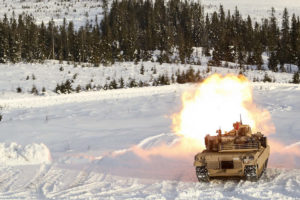
A M1A1 Abrams Tank fires its main gun as it takes part in a live-fire exercise in Rena, Norway, Feb. 18, 2016. The Marines are preparing themselves for Exercise Cold Response 16, which will bring together 12 NATO allies and partner nations and approximately 16,000 troops in order to enhance joint crisis response capabilities in cold weather environments. (U.S. Marine Corps photo by Cpl. Dalton A. Precht/released)
Jeff Groom, a former Marine officer and author of American Cobra Pilot: A Marine Remembers a Dog and Pony Show, writes in The American Conservative that despite the vast differences between Russia today and the Soviet Union, the current American policy toward the Federation is a relic of the Cold War. He writes (abridged):
“They don’t like the fact that we oppose them, and we like the fact that they don’t like the fact that we oppose them. Three hundred of us, surrounded by them, we’ve got them right where we wanted, right?”
This statement was made by the current Sergeant Major of the Marine Corps, Ronald Green, in December of 2017 in reference to the 300-man-strong Marine Rotational Force stationed in Trondheim, Norway, approximately 200 miles north of Oslo. At the invitation of Norway, Marines began six-month training rotations there back in 2017.
Why? Because more than 25 years after the dissolution of the Soviet Union, Russia has seemingly reemerged as a threat to Europe and the world. President Trump’s national security strategy, released in December of 2017, solidifies this stance in “Pillar 3: Preserve Peace through Strength,” which focuses on the return of “great power competition” with Russia and China.
American policy towards Russia now appears identical to what it was during the Cold War: contain the threat. But if the USSR and Russia are not the same by any stretch of the imagination, why is the policy the same, and more importantly, does it work?
Defense spending as a percentage of GDP tripled between 1950 and 1953 from 5 percent to 14 percent.
In the words of President Eisenhower, “we have been compelled to create a permanent armaments industry of vast proportions.”
We needed intelligence on the enemy and hence created the CIA in 1947, the NSA in 1952, and the DIA in 1961.
Think tanks were born to develop policy and guidance. The DoD had to hire thousands more workers to administer the new defense establishment. A real enemy—the Soviet Union—justified a real defense establishment.
As George Kennan foresaw the problem in 1987:
Were the Soviet Union to sink tomorrow under the waters of the ocean, the American military-industrial establishment would have to go on, substantially unchanged, until some other adversary could be invented. Anything else would be an unacceptable shock to the American economy.
To seize Crimea, rather than roll in a column of tanks as in Hungary in 1956, Russia simply marched in unidentified “green men” and claimed the peninsula without a single life lost. The USSR might have fallen, but Russia learned. Our response? In addition to sanctions, $200 million dollars were allotted in the 2018 defense bill to upgrade air bases in Norway, Iceland, and the UK to deter Russia. If that sounds similar to the Cold War strategy of containment, that’s because it is. The system only knows one enemy: the USSR.
The U.S. military base sites in Europe remain numerous and are growing.
In his book Base Nation, David Vine explores our base presence in Europe. The United States has 174 base sites in Germany, 50 in Italy, 21 in Portugal, 27 in the UK, 10 in Belgium, seven in the Netherlands, five in Romania, four in Bulgaria, eight in Greece, and 17 in Turkey.
Read more here.
If you’re willing to fight for Main Street America, click here to sign up for my free weekly email.




